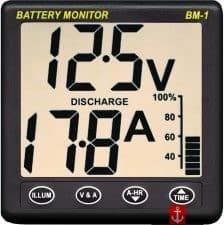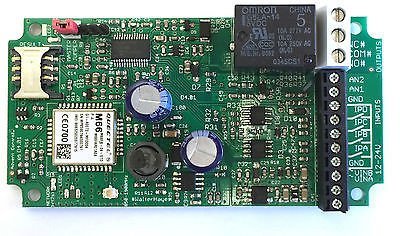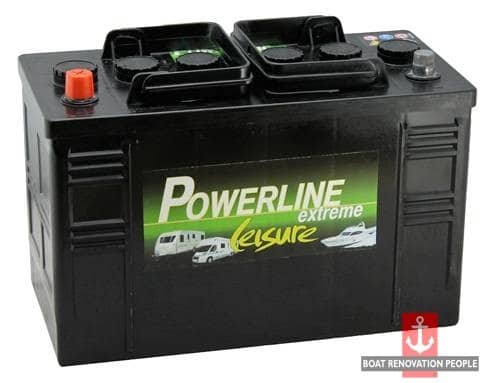Leisure batteries are used to power boats, caravans, motor-homes and many other self-dependent setups. Affordability and availability are what puts leisure batteries at the heart of most off-grid electric setups and for obvious reasons. They allow us the luxury of providing our own ecologically friendly power source often by means of solar power. But while we are dependent on their ability to power our homes, there are a few problems that we forever face;
- Is the battery charged?
- Is the battery holding charge?
- Has your equipment been running e.g bilge pump?
If you know when your battery is failing then you can fix a problem before it becomes a nightmare. There’s nothing worse than turning up to your boat for a weekend cruising, only to find that your battery is flatter than a hedgehog on the motorway and you’re bilge has collected a foot of water!
Monitoring can be just as important for an engine battery especially as they are relied upon to start a boat or vehicle. Before we go into the methods of remote battery monitoring, it’s important to know the difference between the two types of batteries. If you already have a knowledge of batteries then you can use the link below to skip to the juicy bit!
Table of Contents
Skip To An Affordable Method Of Remote Battery Monitoring >>
OR
SKIP straight to the circuit board >>
leisure vs engine batteries?
A leisure battery is designed to provide a low current over a long period of time. You will often hear them named auxiliary batteries; auxiliary meaning “a person or thing providing supplementary or additional help and support”. What does that mean for your weekend trips? Well whilst leisure batteries are ideal for off-grid weekends in boats and vehicles, they aren’t ideal for engines.
A typical engine will often rely on a battery to provide a surge of power to a starter motor. Engine batteries are great for the purpose of kick-starting a motor because once the engine is running it can then return charge back to the battery. However, engine batteries are simply not designed for continuous use due to the exposure to constant recycling (discharge and charge). To put it simply, traditional engine batteries are designed to supply a high current over a short period of time and have a shallow cycle of charge. Leisure batteries, however, are deep cycle and are designed to provide power for a long period of time. To make things even simpler, imagine your morning routine. A coffee will give you a burst of energy for an hour and will get you power walking to work but what you really need is a slow release of energy from a hearty breakfast. Engine batteries are the coffee that gets you running but leisure batteries are the sluggish full-fat fry up that helps you trundle through the morning, day and night.
Lights, pumps, alarms, monitors, diesel heaters and even toilets are just some of the many items that rely on 12 and 24v electric supplies. Many of the items used in boats, vehicles and motor-homes require a constant supply of energy to function, that may not immediately be replaceable by an engine. A 240v trickle charge or solar power supply will replenish a leisure batteries’ power but will often take a prolonged period of time. Engines are generally noisy and will keep anyone living in close proximity awake at night whilst they run. Your neighbours won’t like you either. In fact, they are likely to sink your boat or let down your tyres once you’ve gone out. This means that the power created by an engine or generator needs to captured in a battery that can be used at one’s leisure, conveniently, discreetly and over a period of time and that’s what makes leisure batteries ideal.
Remotely monitoring a battery
Monitoring a battery is important when it provides a standard of living such as light, heat, water, communication, safety and probably the most commonly, transport. Without a fully powered battery, your boat’s engine is not likely to start. Neither will your van after you’ve accidentally left your lights on overnight. Having a flat battery on a car isn’t a major issue, however being at sea with no electric navigation, communication or bilge pumps is an issue and a rather major one at that.
Remote battery monitoring can provide an accurate measurement of a batteries health but there are plenty of other reasons monitoring a battery can be helpful. For example;
- Using a battery to tell if someone has switched on your engine can be a great method of theft detection. If you have jet seat fitted on your boat or vehicle then by using a large red button you could also possibly catapult the thief out of the roof. Better yet, you could lock the doors remotely and play 48 hours of Rick Astley’s – Never Gonna Give You Up followed by the misleading sound of an unlocking door then yet another 48hours of Rick Astley – Never Gonna Give You Up. This is a highly ferocious method that even the guards of Guantanamo Bay would fear.
- Using a battery as an indicator of how often a bilge pump on a boat is activated and whether it follows the pattern of recent rainfall. If it doesn’t there’s a chance that your boat is slowly sinking.
An affordable SOLUTION

Traditionally, people have relied on being in close enough proximity to a boat or vehicle to be able to read the battery monitor/indicator. But due to the constant flow of distractions nowadays taking us away from our pride and joys, this is no longer ideal. What is needed is a tool which allows someone to receive this information via GSM (text message) or wireless internet, whether it be 4g, LTE or a local wireless network. This would allow all information about battery health and usage to be received remotely so you don’t have to worry.
Fortunately, the smart chaps at Advent Controls have been working on an affordable option to resolve this issue. In our previous article about remotely monitoring equipment using GSM devices, we came across an exciting option by Advent Controls which allowed a user to monitor when a bilge pump is activated on a boat. This time they’ve hit the nail on the head again by providing us with another innovative circuit board to monitor batteries remotley.
D4 PCB

The D4 PCB can monitor your battery voltage and can be set to send you a message if it drops below a preset voltage. If you connect AN1 to the battery +VE you can monitor the voltage of your battery remotely. If you send ‘status’ it will reply with the various voltages you’re measuring. If you want an alert when the battery drops below 11.5v say you can set this also.


I am new to boating so this is a very helpful post. Thanks guys!
No worries.